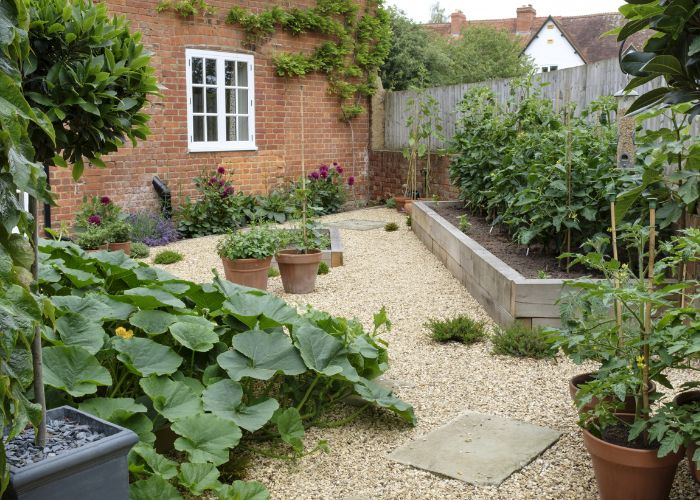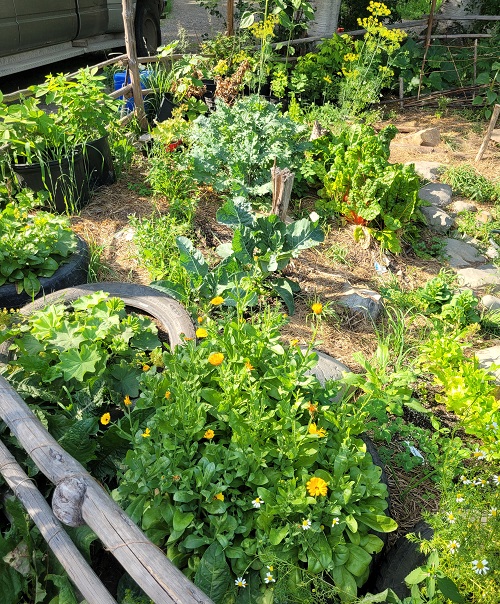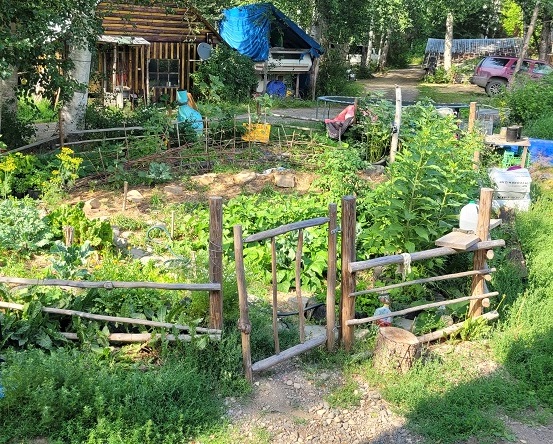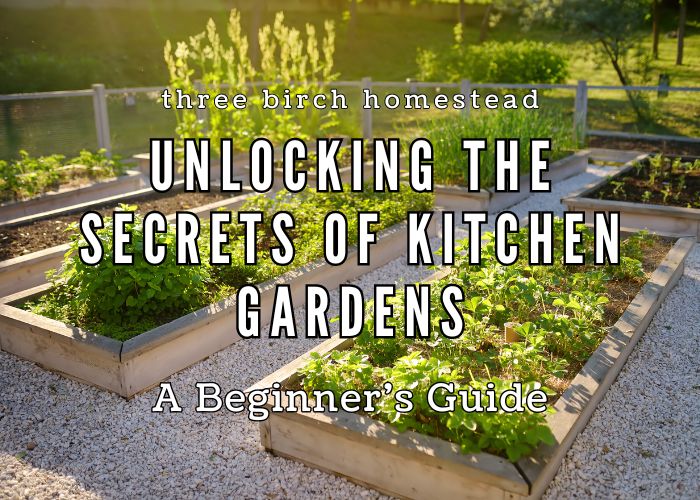In recent years, the concept of kitchen gardening has experienced a resurgence in popularity as more people seek to reconnect with nature and enjoy the fresh flavors of homegrown produce. But what exactly is a kitchen garden, and how can you start your own? Join us as we delve into the world of kitchen gardening and discover everything you need to know to cultivate your own bountiful oasis of fresh herbs, vegetables, and fruits right outside your kitchen door.
What is Kitchen Gardening?
Kitchen gardening, also known as potager gardening, is the practice of growing edible plants near the kitchen for easy access and use in cooking. Unlike traditional vegetable gardens, which may be located farther from the house or on a larger scale, kitchen gardens are typically small, intimate spaces designed for convenience and beauty.
In a kitchen garden, herbs, vegetables, fruits, and edible flowers are carefully selected and arranged in raised beds, containers, or mixed planting beds to maximize space and productivity. The layout is often designed with aesthetics in mind, incorporating design elements such as color, texture, and form to create an attractive and inviting outdoor space.
Table of Contents
- What is Kitchen Gardening?
- The Surge in Kitchen Garden Trends
- Essential Steps to Kickstart Your Kitchen Garden
- Kitchen Garden vs. Traditional Vegetable Garden
- What are the Benefits of a Kitchen Garden?
- Determining the Ideal Size for Your Kitchen Garden
- Choosing the Right Location
- Tending Your Kitchen Garden
- The Varied Purposes of a Kitchen Garden
- The Aesthetic Appeal of Kitchen Gardens
- Plants Grown in Kitchen Gardens
- The Benefits of Embracing a Kitchen Garden Lifestyle
- My Kitchen Garden
- Conclusion
- What do you Think?

The Surge in Kitchen Garden Trends
For me, gardening has always been important, but for many people, this is a new desire that has blossomed in recent years. I attribute this to rising food costs and people getting tired of eating less than optimal food from the grocery store. People want to rely on something other than big agriculture to feed themselves and their families; they want to have some agency over their own food production.
Also, there is more interest in growing food organically and the health benefits of eating fresh food that hasn’t been sprayed with chemicals. There is something so rewarding about picking and eating something you grew in your backyard; you know exactly what went into it.
Additionally, gardening is a productive and relaxing experience that gives people a sense of control in an unpredictable world.
Essential Steps to Kickstart Your Kitchen Garden
Starting a kitchen garden is easier than you might think and doesn’t require a large backyard or years of gardening experience. Here are some essential steps to help you get started:
- Planning Your Garden Layout: Before you start planting, take some time to plan your garden layout and design. Consider factors such as sunlight, soil quality, and available space when choosing the location for your garden beds or containers. A kitchen garden is most often located near the house, somewhere convenient to go out and pick herbs and veggies to add to tonight’s dinner.
- Selecting Suitable Plants and Varieties: Choose a variety of herbs, vegetables, and fruits that are well-suited to your climate and growing conditions. Consider factors such as taste preferences, cooking habits, and space limitations when selecting plants for your kitchen garden. Grow what you eat! There is no point in growing food you don’t like.
- Preparing the Soil and Setting Up Beds: Good soil is essential for a productive kitchen garden. Prepare your soil by adding organic matter such as compost or aged manure to improve fertility and drainage. If you’re planting in raised beds or containers, fill them with a high-quality potting mix or garden soil.
Kitchen Garden vs. Traditional Vegetable Garden
While kitchen gardens and traditional vegetable gardens share some similarities, there are also key differences that set them apart. Here are a few distinguishing features of kitchen gardens:
- Size and Scale: Kitchen gardens are typically smaller in size and scale compared to traditional vegetable gardens, making them ideal for urban or small-space gardening.
- Proximity to the Kitchen: One of the defining features of a kitchen garden is its close proximity to the kitchen, allowing for easy access to fresh herbs, vegetables, and fruits for cooking and culinary use.
- Integration with Outdoor Living Spaces: Unlike traditional vegetable gardens, which may be located in separate areas of the yard, kitchen gardens are often integrated with outdoor living spaces such as patios, decks, or courtyard gardens, creating a seamless transition between indoor and outdoor living areas.
What are the Benefits of a Kitchen Garden?
Cultivating a kitchen garden offers a multitude of benefits, both practical and intangible. Here are some of the key reasons why kitchen gardening is worth exploring:
- Health and Nutritional Benefits: By growing your own fruits, vegetables, and herbs, you have control over what goes into your food, ensuring that it’s fresh, pesticide-free, and packed with nutrients. Incorporating homegrown produce into your diet can lead to improved health and well-being.
- Environmental Sustainability: Kitchen gardening promotes sustainable and eco-friendly practices by reducing food miles, minimizing packaging waste, and conserving water and resources. Growing your own food also helps to protect biodiversity and support local ecosystems.
- Cost Savings and Economic Considerations: Growing your own food can lead to significant cost savings over time, especially if you’re able to produce a large portion of your family’s fruits and vegetables. Additionally, kitchen gardening can be a rewarding and cost-effective hobby that provides enjoyment and satisfaction.
Determining the Ideal Size for Your Kitchen Garden
The size of your kitchen garden will depend on several factors, including the amount of available space, your gardening goals, and your level of experience. Here are some considerations to help you determine the ideal size for your kitchen garden:
- Assess Available Space and Resources: Take stock of your available space, whether it’s a small backyard, balcony, or windowsill, and consider how much room you have to work with. Keep in mind that kitchen gardens can be adapted to fit any size or shape of space, so don’t be discouraged if you have limited room to work with.
- Scale and Scope of Planting Beds: Decide how many planting beds or containers you want to incorporate into your kitchen garden and how much space each one will require. Consider factors such as plant spacing, companion planting, and crop rotation when planning the layout of your garden beds.
- Tailor Size to Household Needs and Preferences: Consider the needs and preferences of your household when determining the size of your kitchen garden. If you have a large family or enjoy cooking and entertaining, you may want to allocate more space for growing a wider variety of crops. On the other hand, if you’re just starting out or have limited time and resources, you may prefer to start small and gradually expand your garden as you gain experience.
Choosing the Right Location
The location of your kitchen garden plays a crucial role in its success, as it determines factors such as sunlight, soil quality, and accessibility. Here are some strategic considerations to keep in mind when choosing the right location for your kitchen garden:
- Sunlight and Shade Requirements: Most edible plants require full sun to thrive, so choose a location for your kitchen garden that receives at least 6-8 hours of direct sunlight per day. Avoid areas that are shaded by buildings, trees, or other structures, as this can limit plant growth and productivity.
- Proximity to Water Source: Access to water is essential for a healthy and productive kitchen garden, so choose a location that is conveniently located near a water source such as a hose or outdoor faucet. Consider factors such as irrigation options, drainage, and soil moisture when selecting the location for your garden beds or containers.
- Protection from Wind and Pests: Choose a location for your kitchen garden that offers protection from strong winds, which can damage delicate plants and reduce yields. Consider using windbreaks such as fences, walls, or shrubs to create a sheltered microclimate for your garden. Additionally, take steps to protect your garden from pests such as insects, birds, and small animals by installing barriers, using companion planting techniques, and practicing good garden hygiene.
Tending Your Kitchen Garden
Tending to your kitchen garden is a rewarding and enjoyable experience that requires time, effort, and dedication. Here are some essential tips for mastering the art of gardening and ensuring the success of your kitchen garden:
- Watering and Irrigation Techniques: Proper watering is essential for the health and vitality of your plants, especially during hot, dry weather. Water your garden regularly, keeping the soil consistently moist but not waterlogged. Consider using drip irrigation, soaker hoses, or watering cans to deliver water directly to the base of your plants and minimize water waste.
- Soil Maintenance and Fertilization: Good soil is the foundation of a healthy garden, so it’s essential to maintain soil fertility and structure through regular soil testing and amendment. Add organic matter such as compost, aged manure, or worm castings to improve soil fertility, structure, and drainage. Consider using natural fertilizers such as fish emulsion, seaweed extract, or compost tea to provide essential nutrients to your plants and promote healthy growth.
- Pest and Disease Management Strategies: Protecting your kitchen garden from pests and diseases is essential for ensuring the health and productivity of your plants. Practice good garden hygiene by keeping your garden clean and free of debris, weeds, and diseased plants. Monitor your garden regularly for signs of pest or disease damage, and take prompt action to address any problems using organic pest control methods such as handpicking, insecticidal soaps, or botanical sprays.
The Varied Purposes of a Kitchen Garden
Kitchen gardens serve a variety of purposes beyond providing fresh, nutritious produce for cooking and culinary use. Here are some of the key reasons why kitchen gardens are worth exploring:
- Culinary Uses and Fresh Ingredient Availability: One of the primary purposes of a kitchen garden is to provide a convenient and readily available source of fresh herbs, vegetables, and fruits for cooking and culinary use. By growing your own produce, you can ensure that your meals are made with the freshest, most flavorful ingredients possible, enhancing the taste and quality of your dishes.
- Educational Opportunities for Children and Adults: Kitchen gardens offer valuable educational opportunities for children and adults alike, providing hands-on learning experiences that promote a deeper understanding of where food comes from and how it’s grown. Gardening teaches essential life skills such as responsibility, patience, and teamwork while fostering a connection to nature and the environment.
- Therapeutic and Stress-Relief Benefits: Gardening has been shown to have numerous therapeutic benefits for both physical and mental health, including stress relief, relaxation, and improved mood. Spending time outdoors in the garden can provide a welcome escape from the stresses of daily life, allowing you to connect with nature, get some exercise, and enjoy the beauty of your surroundings.
The Aesthetic Appeal of Kitchen Gardens
In addition to their practical benefits, kitchen gardens also offer numerous aesthetic advantages, transforming ordinary outdoor spaces into beautiful and inviting landscapes. Here are some ways to enhance the beauty of your kitchen garden and elevate your outdoor space:
- Incorporating Design Elements and Ornamental Features: Add visual interest and personality to your kitchen garden by incorporating design elements such as paths, borders, and focal points. Consider using decorative materials such as stone, gravel, or wood to create pathways and define garden beds, or add ornamental features such as sculptures, birdbaths, or garden art to create focal points and visual interest.
- Enhancing Curb Appeal and Property Value: A well-designed and maintained kitchen garden can significantly enhance the curb appeal and value of your property, making it more attractive to potential buyers and enhancing your overall enjoyment of your outdoor space. Consider planting a mix of colorful flowers, foliage, and edible plants to create a vibrant and inviting garden that adds beauty and character to your home.
- Creating Outdoor Living Spaces: Extend the functionality of your kitchen garden by creating outdoor living spaces such as patios, decks, or seating areas where you can relax, entertain, and enjoy the beauty of your surroundings. Add comfortable outdoor furniture, shade structures, and lighting to create a comfortable and inviting outdoor retreat that you can enjoy year-round.
Plants Grown in Kitchen Gardens
One of the joys of kitchen gardening is the opportunity to grow a diverse array of plants, from culinary herbs and vegetables to edible flowers and fruits. Here are some of the most popular and versatile plants grown in kitchen gardens:
- Culinary Herbs: Fresh herbs are essential for adding flavor and aroma to your favorite dishes, and they’re easy to grow in a kitchen garden. Some popular culinary herbs to consider growing include basil, parsley, cilantro, rosemary, thyme, and oregano. Whether you’re making homemade pesto, seasoning a soup, or garnishing a salad, having a selection of fresh herbs on hand is a game-changer in the kitchen.
- Leafy Greens: Leafy greens such as lettuce, spinach, kale, and Swiss chard are nutritious and versatile vegetables that thrive in kitchen garden settings. Plant them in raised beds, containers, or vertical gardens for easy access and continuous harvest throughout the growing season. Use them in salads, stir-fries, smoothies, or sandwiches for a healthy and delicious dose of greens.
- Root Vegetables: Root vegetables such as carrots, beets, radishes, and turnips are hearty and nutritious crops that are well-suited to kitchen garden environments. Plant them in loose, well-draining soil and keep them well-watered for best results. Harvest them when they reach maturity for a flavorful and satisfying addition to soups, stews, and roasted vegetable dishes.
- Fruit-bearing Plants: While many kitchen gardens focus primarily on vegetables and herbs, fruit-bearing plants such as strawberries, raspberries, blueberries, and dwarf fruit trees can also be incorporated into the design. Plant them in containers or raised beds and provide them with plenty of sunlight and water for optimal growth and fruit production. Enjoy fresh berries straight from the garden, or use them in pies, jams, and desserts for a sweet and satisfying treat.
The Benefits of Embracing a Kitchen Garden Lifestyle
Embracing a kitchen garden lifestyle offers numerous benefits for your health, well-being, and overall quality of life. Here are some of the key advantages of incorporating a kitchen garden into your home:
- Healthier Eating Habits: By growing your own fruits, vegetables, and herbs, you have access to fresh, nutritious produce that is free from pesticides, chemicals, and preservatives. Incorporating homegrown produce into your meals can lead to healthier eating habits and improved overall nutrition, helping you feel more energized and vibrant.
- Reduced Environmental Impact: Kitchen gardening promotes sustainable and eco-friendly practices by reducing food miles, minimizing packaging waste, and conserving water and resources. By growing your own food, you can reduce your carbon footprint and contribute to a healthier planet for future generations.
- Increased Physical Activity: Gardening is a physically active hobby that provides numerous health benefits, including improved cardiovascular fitness, muscle strength, and flexibility. Spending time outdoors in the garden can help you stay active, reduce stress, and improve your overall sense of well-being.
- Enhanced Mental Health and Well-Being: Gardening has been shown to have numerous mental health benefits, including reduced stress, anxiety, and depression. Spending time in nature, engaging in hands-on activities, and nurturing living plants can help promote relaxation, mindfulness, and a sense of connection to the natural world.
- Sense of Pride and Accomplishment: Successfully growing your own food can be incredibly rewarding and satisfying, giving you a sense of pride and accomplishment in your gardening efforts. Whether you’re harvesting your first ripe tomato or enjoying a meal made with ingredients from your garden, the sense of satisfaction that comes from growing your own food is unparalleled.
My Kitchen Garden

My kitchen garden is located just outside my front door. It’s a circular garden with a wooden fence around it to keep my dogs out (and make it look pretty). Everything is grown in-ground or in tires. We have it located in a sunny spot, with access to water.

In my kitchen garden, I plant leafy greens like lettuce, kale, and Swiss chard. I grow edible pod peas (I grow my non-edible-pod peas in my vegetable garden) and culinary herbs that don’t need a greenhouse. I also grow flowers like cosmos, nasturtiums, and sunflowers for their beauty and to attract pollinators. Additionally, I plant cherry tomatoes and zucchini.

I love my kitchen garden. It isn’t picture perfect but it serves our family well. I love the convenience of having food right out my doorstep. There are many evenings when we think, what should we make for dinner? And I can just go to the kitchen garden and see what’s ready to ear.
Conclusion
In conclusion, a kitchen garden is much more than just a practical way to grow your own food—it’s a lifestyle choice that offers numerous benefits for your health, well-being, and overall quality of life. By embracing the principles of kitchen gardening and incorporating them into your home, you can create a thriving oasis of fresh, delicious produce right outside your kitchen door. Whether you’re a seasoned gardener or a complete beginner, there’s never been a better time to start your own kitchen garden and reap the rewards of homegrown goodness. So roll up your sleeves, dig in the dirt, and let the magic of gardening transform your life, one plant at a time. Happy gardening!
What do you Think?
What are your thoughts on kitchen gardening? Have you ever tried it before? If so, what tips do you have for beginners? If not, what’s holding you back? Let’s start a conversation!
